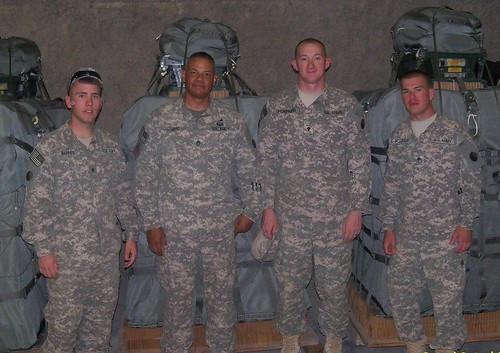Story and photos by 1st Lt.Gregory Slater & Spc. Matthew Magreta, 1204th Aviation Support Battalion
[caption id="" align="aligncenter" width="500"]

Soldiers near Camp Buehring, Kuwait await an air drop from Air Force cargo planes. The air drop was part of a joint training exercise for Joint Precision Aerial Drop Systems (JPADS).(Kentucky National Guard photo by 1st Lt. Gregory Slater, 1204th ASB/Released)
CAMP BUEHRING, Kuwait - The forward operating bases of the conflicts in Southwest Asia are at times too remote to be resupplied by convoy. These FOB's continue to operate, however, thanks to the abilities of Army and Air Force airdrops. Food, clothing, thousands of barrels of fuel, construction materials and ammunition have all found their way to the FOBs because of this aerial support.
Kentucky National Guardsmen of the 1204th Aviation Support Battalion recently received training to contribute to those efforts.
Four Soldiers from 1204th, Staff Sgt. David Davis, Spc. Kyle Barnes, Spc. Evan Scoskie and Spc. Dillion Hoepker were chosen to participate in Joint Precision Air Drop System (JPADS) recovery training. The soldiers received extensive hands-on training in preparing the system for an air drop mission and recovering of sensitive equipment. These Soldiers were then tasked to train other Soldiers from the 1st Battalion, 7th Cavalry that would augment the 1204th recovery team.
After months of planning, the Army and Air Force held a multi-unit proof-of-concept exercise testing Joint Precision Airdrop Systems operations. The event took place May 19, on the north side of Camp Buehring and consisted of approximately 60 troops from the 29th Combat Aviation Brigade, 1-7 Cavalry, and the Air Force.
[caption id="" align="alignright" width="400"]

Left to right: Spc. Kyle Barnes, Staff Sgt. David Davis, Spc. Dillon Hoepker and Spc. Evan Scoskie of the 1204th Aviation Support Battalion in Al Udeid, Qatar. The Soldiers were trained as part of a Joint Precision Aerial Drop System while deployed to Kuwait. (Kentucky National Guard photo by 1st Lt. Gregory Slater, 1204th ASB/Released)
Although JPADS are commonly used in Afghanistan, this was the first time that Kuwait-based units had coordinated as a combined arms team to demonstrate their ability to resupply ground combat units.
"Mission success was contingent upon the positive relationships between U.S. units and our Kuwaiti partners to ensure that airspace was available and clear during the operation," said Lt. Col. Todd Coulson, deputy chief of staff for operations, Task Force 3.1.
The operation was previously delayed due to administrative issues, but last month the exercise was conducted flawlessly with JPADS performing exactly as advertised.
Air Force personnel dropped four bundles totaling 5,000 pounds from a C-17. Flying in at almost 10,000 feet, two pilots and a full crew guided the drops using a Global Positioning System, meteorology data kit and a mission planner laptop. Each bundle varied in size and weight, but each one resembled a giant cube with netting holding the cargo in place. Pushed out by the crew at 130 knots, each bundle traveled roughly eight meters per second with the parachute fully open.
"Each bundle consisted of water, MREs, and (the energy drink) Rip-Its which would simulate a realistic resupply drop to ground combat personnel, located anywhere," said Coulson.
Soldiers from the 1204th ASB and 1-7 CAV were responsible for transportation, security, recovery and safety of the bundles as they immediately touched down in the 360-degree perimeter.
"Before the drop, we do a reconnaissance and a visual sweep of the drop zone to ensure the area is clear of debris, camels and Bedouin Camps," said Capt. Michael Kiser, Alpha Co., 1-7 CAV.
According to Staff Sgt. David Davis of the 1204th ASB, there was a one-minute response time to each bundle. It took the recovery team less than 30 minutes to collect the equipment, parachute, and sensitive items and load them for transport to a more secure location where a unit can then conduct resupply operations.
The drop zone was an open area situated in low ground with clear visibility for miles. Despite having a drop zone of 1,000 meters in radius, a "high accurate" designated point of impact is 300 meters or closer.
[caption id="" align="alignleft" width="350"]

Soldiers of the 1204th Aviation Support Battalion and 1st Battalion, 7th Cavalry, recover Joint Precision Aerial Drop Systems (JPADS) near Camp Buehring, Kuwait. The JPADS were dropped from an Air Force C-17 as part of a training exercise in the region. (Kentucky National Guard photo by 1st Lt. Gregory Slater, 1204th ASB/Released)
"From my perspective, a high altitude precise drop assists in keeping any bundles away from enemy combatants," said Sgt. Sean Huynh, F Co., 1st Battalion, 111th Aviation Regiment.
Used in combat operations in Afghanistan, the main benefit of JPADS is to increase the availability of cargo. With troops stationed in remote forward operating bases, JPADS allows those units to be quickly and regularly resupplied by air where ground transport often is not practical. Regardless of location or situation, JPADS offers all armed forces a way to stay well equipped.
"I have worked with JPADS for seven years as an infantryman on the ground and experienced the benefits firsthand," said Coulson. "The recovery might be difficult in four feet of snow in the Afghan mountains making the precision of the delivery invaluable for those Soldiers who may have to conduct recovery in a hostile environment."
There are four weight increments that are authorized for use with JPADS. This operation was classified as an "extra light" category of 2,200 pounds or less. However, a bundle can hold as much 60,000 pounds of weight if a mission dictates.
"Pray for good weather, talk to the pilots constantly, and over-communicate with one another throughout the planning. That is the secret of a successful operation," said Coulson.